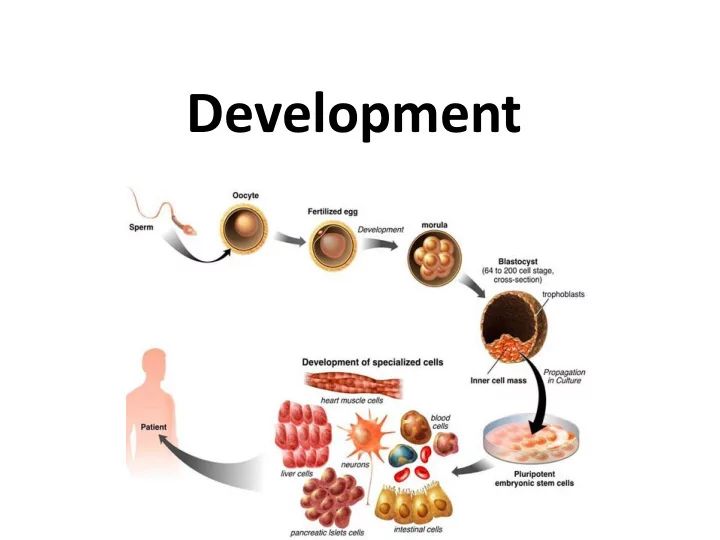

Development
Model Organisms
Model Organisms • Used to study embryonic development • Usually reproduce quickly and are easy to raise in a laboratory setting • Classic model organisms include: – Drosophila (fruit fly) – C. elegans (nematode worm) – Saccharomyces (yeast) – Zebrafish
Why do scientists use specific model organisms? • Genetic similarity to humans • Easy to house and care for • Impact of genetic manipulation or drug treatment is easy to see (transparent embryos) • Lots of offspring • Easier to induce genetic changes
Embryonic Development • Three processes: cell division, cell determination, cell differentiation, and morphogenesis
Early Embryonic Development
Early Embryonic Development • Cell division only produces a ball of identical cells called a blastocyst (or blastula) • Three germ layers: • Ectoderm: epidermis, nervous tissue • Mesoderm: muscle, cartilage, bone, blood vessels, other connective tissue • Endoderm: digestive lining, respiratory organs
Stem Cells • Stem cells are pluripotent : cells capable of differentiating into any type of cells • Embryonic stem cells can generate all cell types • Adult stem cells generate a limited number of cell types
Embryonic Stem Cells
How do stem cells differentiate into all the different types of cells?
Early Gene Expression in the Embryo • What “tells” a cell which genes to express in the embryo? 1. Cytoplasmic Determinants (maternal) : components of the egg cytoplasm (mRNA, proteins, chemicals, etc.) are unevenly distributed to cells during division of the zygote 2. Inductive Signals: molecules released by embryonic cells signal nearby cells to change their gene expression
Cytoplasmic Determinants • Acts as activators that turn on specific genes • Internal cue
Inductive Signals • Signals that change gene expression in a target cell ( external cue ) – cells influence other cells, environmental influence • Influence pattern formation : body plan or spatial organization of tissues and organs
Determination Differentiation Morphogenesis
Determination • Cell is “committed” to its cell type ( cell fate ) very early in embryonic development, but differentiation is not observable…….yet • Determination of a cell is under the influence of master regulatory genes
Master Regulatory Genes • Genes that control development by controlling the expression of other genes • Examples include : • myoD • SRY gene • homeotic genes (example HOX genes)
myoD • MyoD is a master regulatory gene involved in muscle cell determination and differentiation
SRY gene • Master regulatory gene • SRY protein acts as a transcription factor to regulate the expression of genes involved in determining maleness
Homeotic Genes • Examples of master regulatory genes that control pattern formation (body plan) in the late embryo, larva, and adult • Examples include HOX genes
Homeotic Genes
Evolution – Your Favorite Subject!
Determination • Determined cells then express genes for tissue specific proteins: found only in a specific cell type, gives the cell its characteristic structure and function ( differentiation ) • Determined cells then further differentiate and become specialists for a specific type of protein
Differentiated Cells Produce Tissue Specific Proteins
Differentiation and Morphogenesis • Differentiation: cells become specialized in structure and function • Morphogenesis: specialized cells are organized into tissues and organs to develop the form of the organism • Depends on gene expression and protein production
Cell Differentiation • Differences between cell types is due to differential gene expression • Regulation of transcription of genes comes from hormones or other signaling molecules
Morphogenesis • Process that causes an organism to develop its shape • Involves the spatial distribution of cells
Mutations Cause Abnormal Development • HOX genes play a role in limb pattern formation • Mutation in HOXD13 gene results in human polysyndactyly – Extra fingers or toes and webbed
What are some other factors involved in normal embryonic development?
Other Factors Involved in Development • Apoptosis • Changes in gene expression: 1. Histone acetylation 2. DNA methylation 3. microRNAs (miRNAs)
Role of Apoptosis • Embryonic apoptosis events are highly programmed and predictable in location, time and amount • Plays a key role in the morphogenesis of fingers and toes • Splits layers of tissues (i.e. lumen of intestine) • Nervous and immune system – overproduce cells and then destroy those that don’t function
Apoptosis
microRNAs • Small sequences of non-protein coding RNA (~20 nucleotides) that bind to complementary mRNA molecules • miRNAs are able to block protein translation or degrade mRNA and effectively regulate gene expression
Recommend
More recommend